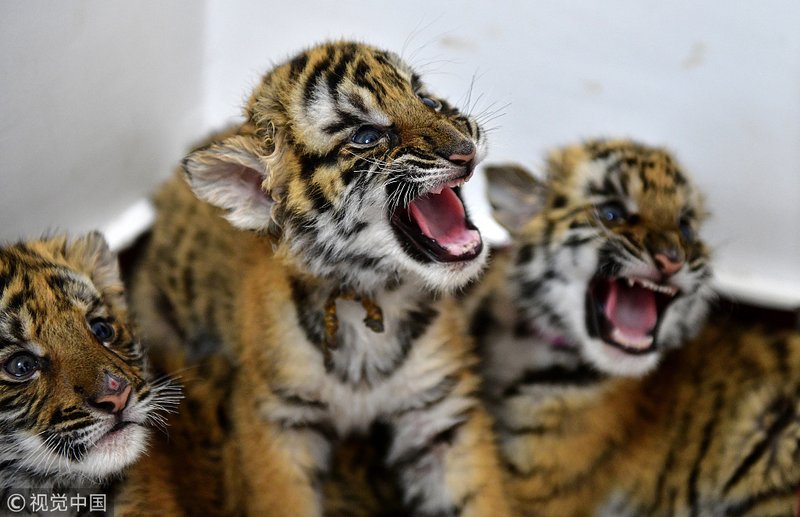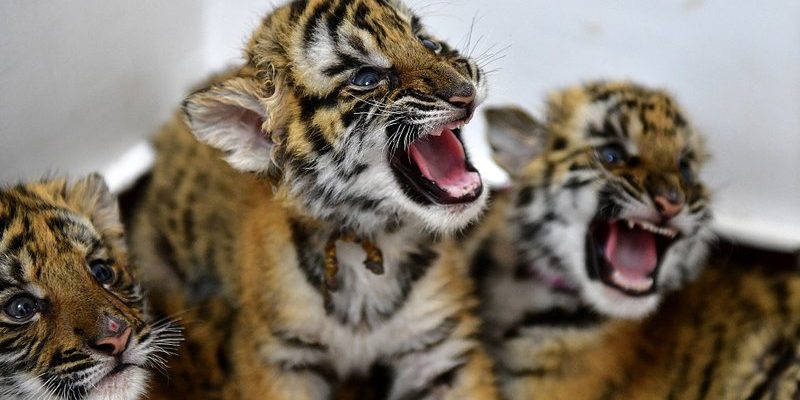
Imagine a mother tiger navigating through the thick, green underbrush of the forests of southern China, teaching her little ones how to hunt, play, and survive. With only a few hundred of these tigers left, their parenting strategies are vital not just for their survival, but also for the future of the species. Here’s a closer look at how South China tigers raise their young in the wild, from birth to independence.
The Birth of Cubs: A Critical Beginning
The journey of a South China tiger mother begins when she gives birth, typically to a litter of two to four cubs. This moment is crucial as the cubs are born blind and completely dependent on their mother. The first few weeks are spent in a secluded den, often hidden in dense vegetation, which offers protection from predators. The mother will stay close, keeping them warm and nursing them regularly.
During this early stage, the mother’s dedication is unwavering. She uses her sense of smell and the sounds of the forest to ensure the den is safe. If threats loom, she may even move her cubs to a different location. You might be wondering how she knows when it’s time to move. Tigers have excellent instincts and can sense danger, often before it appears.
As the cubs grow, they start to open their eyes and explore their surroundings at around two months old. This is when the fun begins, and their playful nature emerges. They’ll wrestle with each other, practicing the skills they’ll need as adults. These little moments are crucial for their development, helping them learn social interactions and building the bond with their mother.
Nutrition and Hunting Lessons
Once the cubs reach about three months, it’s time for solid food. The mother begins to introduce them to the meat of their prey, like deer and wild boar. This transition is vital because hunting is a skill that must be learned. At first, they’ll watch their mother hunt, observing her stealth and agility. You could say this is like a student watching their teacher, soaking in every detail.
As the cubs grow stronger and more confident, their mother encourages them to practice hunting themselves. You might think of these lessons as a series of miniature adventures—she’ll take them to a safe area where they can practice stalking and pouncing on small animals. The thrill of the chase helps build their strength, coordination, and confidence.
However, here’s the thing: while these lessons are critical, they can also be dangerous. The mother keeps a close eye on her cubs. She understands the balance between allowing them to explore and ensuring they’re safe from potential threats. It’s a game of patience and skill, where every experience counts.
Bonding Through Play
Playtime is not just fun and games for the young South China tigers; it’s an essential part of their development. During these playful interactions, they learn important survival skills, like fighting and cooperation, which will serve them well in the wild. You can think of it as a kind of wild boot camp where they practice for the challenges ahead.
While the mother is always nearby, she sometimes lets her cubs engage in rough play with one another. It’s a natural way for them to learn their limits and how to interact with other tigers. Over time, you can see the bond between the mother and her cubs deepen. All of this playful behavior serves a purpose—it enhances their social skills and prepares them for adult life.
As they grow older, the mother begins to gradually withdraw her direct involvement during play, allowing them more autonomy. It’s a bit like a parent teaching a child to ride a bike—initial support fades, but the confidence built lasts a lifetime.
Becoming Independent: The Transition
Around the age of two years, the cubs are approaching independence. By this time, they have learned essential survival skills and are ready to venture out on their own. However, this transition isn’t just a sudden jump; it requires careful preparation. The mother will begin to spend less time with them, encouraging them to hunt and explore their environment independently.
During this period, the cubs may still return to their mother for guidance and companionship, reflecting a natural and gradual split. Here’s the thing: even as they grow more self-sufficient, they will always carry the lessons learned from their mother—both in hunting techniques and the understanding of their territory.
As they carve out their own paths, they must also negotiate their places in the social hierarchy of their species. This can involve some conflicts with other tigers, making their social skills even more vital.
Challenges in the Wild
Raising young tigers comes with its own set of challenges. With habitat loss and poaching affecting their environment, survival isn’t just about having the right skills. Mother tigers face threats from other predators and even humans. These external pressures can lead to tough choices regarding where to raise their young.
Additionally, food scarcity can force mothers to travel greater distances to find prey. This often requires them to leave their cubs alone for longer periods, which can be stressful for both the mother and her young. As cubs become more mobile and curious, the risk of leaving them alone increases. Honestly, this is one of the many stresses that a tiger mother must manage throughout her parenting journey.
Despite these challenges, the bond between a mother and her cubs remains strong. Each lesson learned in the wild, whether it be about hunting or navigating danger, is a step toward ensuring the survival of the South China tiger as a species.
Conservation Efforts and the Future
With only a few hundred South China tigers left in the wild, conservation efforts play a vital role in their future. Organizations and governments are working together to protect their natural habitats and ensure safe environments for these magnificent creatures to raise their young.
By increasing awareness about the importance of tiger conservation, we can help ensure that future generations get to witness these incredible animals in their natural habitats. Educational programs and community involvement are crucial for fostering an understanding of the challenges these tigers face.
As we reflect on the journey of the South China tiger—from the birth of its cubs to the challenges of independence—it’s clear that every step counts. The future of this endangered species depends on successful parenting in the wild and our commitment to preserving their environment.
In conclusion, the way South China tigers raise their young is a captivating blend of instinct, skill, and deep-seated environmental awareness. By understanding their parenting strategies and supporting conservation efforts, we can play a part in ensuring these beautiful creatures thrive for years to come.

